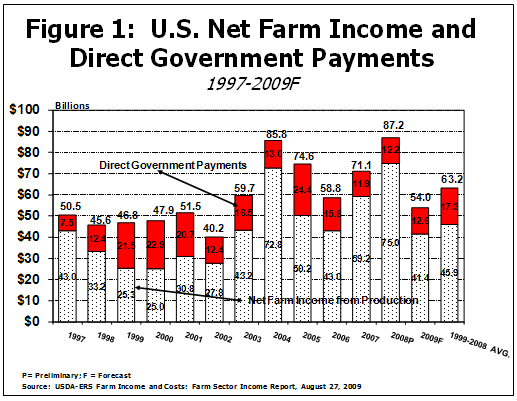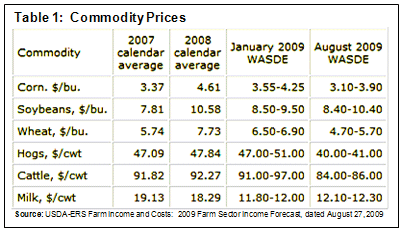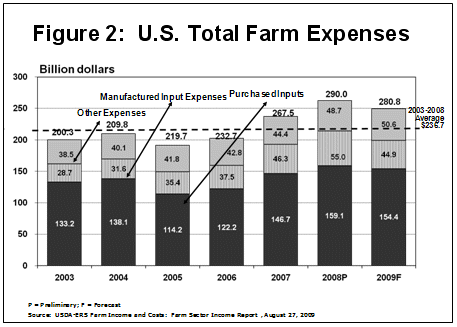Vol. 25, Issue 29, September 9, 2009 – PDF version
Jose G. Peña, Texas AgriLife Extension Economist-Management
After two consecutive years of record high net farm income, USDA’s August 27, 2009, estimate of U.S. net farm income for 2009 at $54.1 billion is down $17.1 billion (24 percent) from USDA’s initial estimate of $71.2 billion in March ’09 and down $33.2 billion (38 percent) from last year’s record preliminary estimate of $87.2 billion. The 2009 forecast is $9 billion below the average of $63.2 billion in net farm income during the past 10 years (See Figure 1). Last year’s record net farm was driven by a large increase in the value of crop production which was partially offset by higher production costs. Commodity prices increased at a higher rate than input costs. This year commodity prices are down significantly, while input costs remain relatively high. USDA’s 2009’s estimates of three basic income measures are down significantly from 2008: net cash income, down 30 percent; net value added, down 22.4 percent; and net farm income, down 38 percent.
 In 2008, prices for both farm commodities and farm production inputs spiked in the first half of the year, plunged in the latter half, but remained high by historic standards. Increased demand for corn for ethanol production moved commodity prices higher and a relatively weak dollar attracted increased exports. Ending stocks of many commodities dropped, but commodity prices trended downward late in 2008 as national and world economies softened.
In 2008, prices for both farm commodities and farm production inputs spiked in the first half of the year, plunged in the latter half, but remained high by historic standards. Increased demand for corn for ethanol production moved commodity prices higher and a relatively weak dollar attracted increased exports. Ending stocks of many commodities dropped, but commodity prices trended downward late in 2008 as national and world economies softened.
USDA-ERS August 2009 income estimates indicated that the outlook for the farm economy for 2009 appears as a continuation of the end of 2008. Crop prices continued to decline in 2009 and prices for livestock animals and products have experienced sharp declines. Export demand has declined as the global economy remains weak and production remains high, causing prices to weaken. Table 1 provides a comparative summary of U.S. price estimates for selected commodities.
 Production Costs Down 3%
Production Costs Down 3%
USDA-ERS August, 2009 forecast report indicated that U.S. production expenses in 2009 are expected to drop $9.2 billion (3.2 percent) from 2008’s record high of $290.0 billion, but still leave farm expenses $13.3 billion (4.97%) higher than 2007 (See Figure 2). The reduction in gross income will be larger than the reduction in costs, leaving all measures of income and output below the record levels established in the past two years.
 According to USDA-ERS estimates, while the value of crop production is expected to decline $17.8 billion (11.8%) in 2009, it is still projected to remain $46.9 billion above the average value of crop production over the previous 10 years. The total value of livestock production is expected to decline by $21.8 billion, led by an $11.8-billion drop in dairy production and a $7-billion decline in sales of meat animals (cattle, hogs, and sheep). With some offset from lower farm production costs (most notably, feed, fertilizer and fuel) projected in 2009, net value added is forecast to be down $30.4 billion (22.4 percent).
According to USDA-ERS estimates, while the value of crop production is expected to decline $17.8 billion (11.8%) in 2009, it is still projected to remain $46.9 billion above the average value of crop production over the previous 10 years. The total value of livestock production is expected to decline by $21.8 billion, led by an $11.8-billion drop in dairy production and a $7-billion decline in sales of meat animals (cattle, hogs, and sheep). With some offset from lower farm production costs (most notably, feed, fertilizer and fuel) projected in 2009, net value added is forecast to be down $30.4 billion (22.4 percent).
Increased Financial Risk
Meanwhile, direct government payments are expected to total $12.6 billion in 2009, down slightly from the $12.2 billion in 2008, but 20 percent below the 5-year average for 2004-08. Counter-cyclical payments are forecast to increase by $518 million (72%) to $1.23 billion in 2009, primarily as a result of the drop in cotton prices during the latter half of 2008.
Total Direct and Counter-Cyclical Program (DCP) payments are forecast at $5.15 billion for 2009, about a five percent decrease from the average of the previous five years. This decrease would tend to indicate that the farm sector is carrying more financial risk as commodity prices decrease.
In terms of the Average Crop Revenue Election (ACRE) program participation, since producers’ enrollment in the ACRE program were lower than expected, the effect of the ACRE program on direct payments in calendar year 2009 is not yet known.
Appreciation is expressed to Dr. Danny Klinefelter, Extension Economist for his contribution to review of this article.
